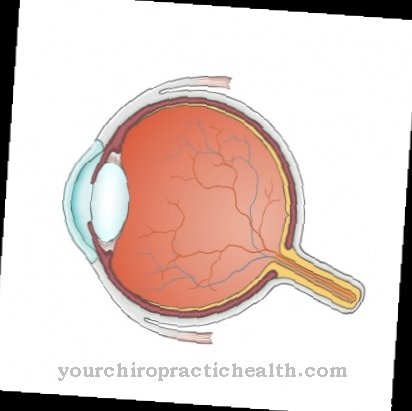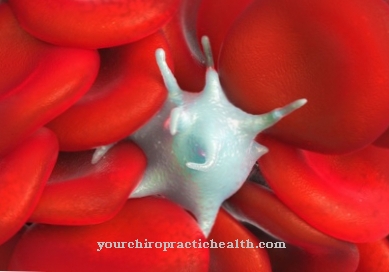As meiosis is a form of cell division in which, in addition to cell division, the diploid chromosome set is reduced to a haploid chromosome set so that the newly created cells each have only one chromosome set.
In the human organism, meiosis is used to generate haploid germ cells with a simple set of chromosomes from diploid primordial germ cells (eggs in the ovary and sperm in the testes).
What is meiosis

Meiosis, also called meiosis or reduction division, occurs in girls and boys for the first time during sexual maturity, between the ages of 12 and 14 years. From the diploid primordial germ cells already created in the embryonic stage, haploid gametes develop, germ cells each with a set of chromosomes.
During meiosis, four haploid daughter cells are formed from one diploid cell. Because after the reduction division of the cell with division of the two sets of chromosomes to both daughter cells, the second meiotic division immediately follows, which is comparable to normal cell division (mitosis). The two daughter cells divide again, so that a total of four haploid daughter cells arise.
In men, during meiosis, four sperm cells of equal value, but with differently recombined genes, are formed from a primordial germ cell. In women, the balance sheet after meiosis is a little different. In the first phase, which takes place shortly before ovulation, a large cell is created that contains almost the entire cytoplasm and a haploid set of chromosomes and a small cell (polar body) with also a set of chromosomes and very little cytoplasm.
During the subsequent mitosis, which only takes place after ovulation, both cells divide again, taking their set of haploid chromosomes with them. However, the division of the large cell is again asymmetrical. The result is the large egg cell and another small polar body, so that in the overall balance, meiosis has set off a fertilizable egg and three small, non-viable polar bodies.
Function & task
Due to sexual reproduction, meiosis or reduction division is very important to humans for two reasons. The primordial germ cells in both men and women have a diploid set of chromosomes, which would double to a fourfold set of chromosomes if the cells were to be united for the purpose of reproduction.
Therefore, the cells intended for reproduction must undergo a reduction division in order to obtain a diploid zygote after the union of the two cells. The zygote can be seen as the primal mother of the stem cells, from which the entire new individual arises through a multitude of mitoses and special differentiations of the cells.
Although sexual reproduction harbors risks, which lie primarily in spontaneous mutations in the recombination of genes and in the inheritance of gene defects that have occurred, they offer two advantages over asexual cloning in particular, a simple duplication that could be followed by nature with much less risk.
As a result of sexual reproduction, a population emerges with different individuals who can assert themselves differently and successfully in a changing environment. From generation to generation, the predispositions that offer the best conditions for survival can prevail.
On the other hand, among the abundance of unfavorable gene mutations, isolated mutations occur that enable new, previously unknown, abilities that result in progress or better adaptation to changed environmental conditions for the entire population.
Meiosis plays an essential role in these adaptation and development processes. During the complex 1st phase of meiosis, which can be divided into several steps, when the chromosome pairs are separated from one another, there is often a crossing-over. This means that the random combination of the mother and father chromosomes is supplemented by a random exchange of individual homologous chromatids within the chromosomes and the possibilities for recombination are multiplied.
Illnesses & ailments
During the complex individual steps of meiosis, errors with usually serious consequences can occur. The chromosomes can be misaligned or a replication error occurs.
Genes can be assigned to the “wrong” chromosome (translocation) or homologous chromosomes cannot be separated (non-disjunction). Likewise, entire chromosomes in the sex cells can be missing or redundant.
In principle, all chromosomes can be affected, but certain chromosomal disorders are far more common and better known than others. Most chromosomal disorders trigger premature miscarriages or do not lead to pregnancy.
The most famous chromosomal disorder is trisomy 21, also known as Down syndrome. Chromosome 21 or parts of it are present in triplicate. Externally, the disease can be recognized by oblique eyelid folds and there are usually deformations in the nasopharynx and malformations of organs.
The mental development of the children, who are usually open and very cordial, is different. Many of those affected can achieve school leaving qualifications and an independent life.
Klinefelter syndrome is caused by an extra X chromosome in boys. The specific chromosome aberration is often not recognized because the affected person can lead an almost normal life.
Often they have language and reading difficulties and the testes are delayed and weakened with a reduced testosterone production. Because those affected are sterile, the chromosomal disorder is often only diagnosed when the desire to have children is not fulfilled.
The Patau syndrome, also known as trisomy 13, is based on a replication error on chromosome 13. Either there is an additional chromosome 13 (free trisomy 13) or there is a translocation trisomy 13 in which only a certain section of the Chromosome is redundant. Affected babies suffer from severe malformations that affect the brain, digestive tract, heart, kidneys and eyes. A cleft lip and palate is also characteristic.



























